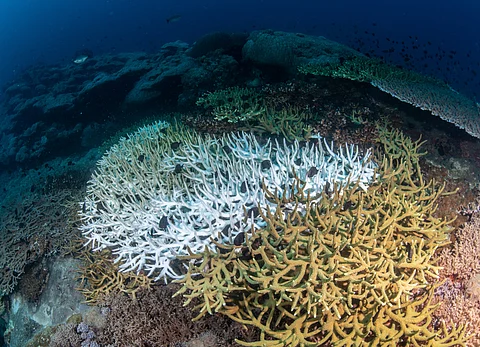

The world’s coral reefs are in the grip of the most extensive bleaching event ever recorded, but scientists say it may take another year to fully grasp how much has been lost.
The ongoing fourth global coral bleaching event (GCBE4), which began in January 2023, has already surpassed the previous largest episode in scale. Scientists are still working to determine the full extent of coral mortality on a global scale. Coral bleaching can result in widespread coral death, disrupting reef ecosystems, threatening marine biodiversity, and affecting human communities that rely on reefs for food, tourism, and coastal protection.
According to the United States National Oceanic and Atmospheric Administration, nearly 83.7 per cent of the world’s coral reefs were experiencing high levels of heat stress, triggering widespread bleaching and increasing the risk of mortality in many areas.
Often described as the “rainforests of the sea,” coral reefs suffer under extreme heat stress much like forests do under wildfires.
The current bleaching event has already surpassed the scale of the previous global event. Between 2014 and 2017, GCBE3 affected 68.2 per cent of the world’s reefs; GCBE4 had, by comparison, impacted at least 15.5 per cent more.
As of April 21, 2025, bleaching had been reported from 82 countries and territories — up from 74 in February 2023.
Now, scientists are still actively compiling data on the impacts of the event, to calculate the mortalities, Derek Manzello, coordinator of NOAA’s Coral Reef Watch, told Down To Earth. “The global scale perspective will still be a year or two away,” he said.
One of the major challenges, the scientist added, lay in the need for in-water surveys to quantify coral mortality. “Long-term monitoring of fixed sites is key to assess the difference between what existed before the bleaching event and how much of the coral died during the event,” he added.
Documentation of reef conditions before, during and after bleaching events is crucial to understanding the full extent of damage, Manzello said.
“For instance, the Caribbean experienced severe bleaching in 2023 and 2024. Scientists are still out in the field to determine how much coral died from the 2024 bleaching. Once the data are collected, they must be analysed and interpreted,” he explained.
Preliminary surveys had begun to shed light on the scale of devastation. In January 2025, scientists reported that the southern Great Barrier Reef (GBR) had experienced extreme heat stress in May 2024, resulting in 44 per cent coral mortality in some protected zones.
Similarly, in the Chagos Archipelago in the Indian Ocean, monitoring revealed a 23 per cent loss in live coral cover between April and June 2024. Another paper reported that up to 85 per cent of coral had been affected by extreme sea-surface temperatures, causing extreme and widespread bleaching.
High ocean temperatures were recorded across the Pacific, Atlantic and Indian Oceans in both the northern and southern hemispheres.
In an earlier interview, Manzello had noted that nearly 99.9 per cent of coral reef areas in the Atlantic Ocean had been exposed to bleaching-level heat stress in 2024.
Even coral reefs previously believed to be relatively insulated from climate extremes — termed thermal refugia — were not spared. These reefs, such as those in Raja Ampat (Indonesia) and the Gulf of Eilat in the northern Red Sea, typically benefit from the cooling effect of deeper ocean waters. Yet these regions too had shown signs of bleaching.
Other highly affected regions included the Ningaloo Coast in the state of Western Australia, the east African coast including Madagascar and iSimangaliso Wetland Park in South Africa.
Post-bleaching assessments in Florida, released in early 2024, indicated a 21 per cent decline in coral cover compared to 2023. Coral abundance in the subregion fell by 28 per cent.
In another study published in April 2024, coral communities in Huatulco, Mexico, showed mortality rates ranging from 50 per cent to 93 per cent across different species after sea surface temperatures exceeded historical records between mid-June and late July.
Terming the ongoing global mass coral bleaching event unprecedented, Britta Schaffelke, of the Australian Institute of Marine Science and coordinator of the Global Coral Reef Monitoring Network (GCRMN), said the event was unprecedented. Speaking with the British newspaper The Guardian, Schaffelke said, “The fact that this most recent, global-scale coral bleaching event is still ongoing takes the world’s reefs into uncharted waters.”